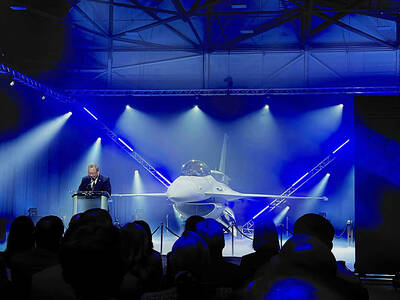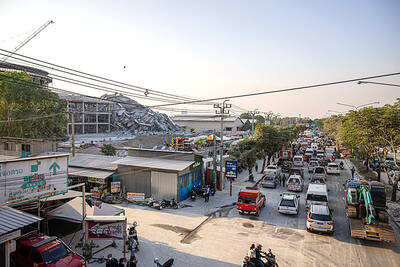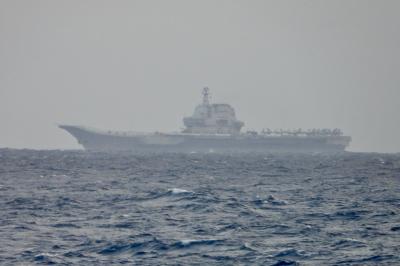The US said on Monday that there was a “possibility” that a barracks for US Marine security forces at the planned new American Institute in Taiwan (AIT) headquarters in Neihu, Taipei City, may be built, but there are no current plans to station Marines at the complex.
State Department spokesman Tom Casey said that a procurement announcement in English-language newspapers in Taiwan last week should not be construed as a change in US policy toward the stationing of US military personnel in Taiwan.
Aside from the assignment of a few US military attaches at the AIT Taipei headquarters in 2005, the presence of US military forces in Taiwan has been barred since the US switched diplomatic recognition from Taipei to Beijing in 1979.
US Marines are deployed as guards at US embassies around the world.
In answer to a question at his daily press briefing, Casey said the ad had created a “bit of confusion.”
“There are discussions about having a new compound or new complex built to replace the existing AIT structure in Taipei. The notices that have gone out have included the broadest possible kinds of elements that might be included in there. But at this point I’m not aware that there are any plans to station US Marines at AIT in Taipei,” Casey said.
Asked whether a Marine barracks is being planned, Casey said: “That’s a possibility. But it’s not. Again this is a request for proposals on a range of options for a new building and for a new compound. And again there certainly would be a security element to that. There’s a security element in AIT there right now, though it isn’t US Marines that are providing it.”
He said that procurement ads are not “indicative of anything more” than that in seeking a contractor, the US wants to give bidders a “full range of options.”
“I don’t think anyone should see this as a signal that we’re changing our policy or that we intend to place Marines at this point at AIT Taipei,” he said.
Plans for the Neihu complex have been in the works for several years, but the government has not yet funded the entire project. In its budget request for the next fiscal year, which begins on Oct. 1, the US State Department called for sufficient funding to pay for the facility, which it estimated would cost more than US$170 million.
However, it put the new facility under the budget category of “strategic capital,” a subset of its Worldwide Security Upgrade budget line which emphasized “critical maintenance and infrastructure investment,” with a reference to Iraq and the security problems there.
The new AIT facility was the only one mentioned in the “strategic capital” section.
The AIT section of the budget commented that there “remains a need for critical facilities upgrades other than security [eg, strategic, policy or political considerations].”
“The FY [fiscal year] 2009 Strategic Capital request, when combined with funding previously provided from proceeds of sale and contributions by the American Institute in Taiwan, will provide [US]$171.6 million for the construction of a new office compound in Taipei, Taiwan,” the budget request said.

AIR SUPPORT: The Ministry of National Defense thanked the US for the delivery, adding that it was an indicator of the White House’s commitment to the Taiwan Relations Act Deputy Minister of National Defense Po Horng-huei (柏鴻輝) and Representative to the US Alexander Yui on Friday attended a delivery ceremony for the first of Taiwan’s long-awaited 66 F-16C/D Block 70 jets at a Lockheed Martin Corp factory in Greenville, South Carolina. “We are so proud to be the global home of the F-16 and to support Taiwan’s air defense capabilities,” US Representative William Timmons wrote on X, alongside a photograph of Taiwanese and US officials at the event. The F-16C/D Block 70 jets Taiwan ordered have the same capabilities as aircraft that had been upgraded to F-16Vs. The batch of Lockheed Martin

GRIDLOCK: The National Fire Agency’s Special Search and Rescue team is on standby to travel to the countries to help out with the rescue effort A powerful earthquake rocked Myanmar and neighboring Thailand yesterday, killing at least three people in Bangkok and burying dozens when a high-rise building under construction collapsed. Footage shared on social media from Myanmar’s second-largest city showed widespread destruction, raising fears that many were trapped under the rubble or killed. The magnitude 7.7 earthquake, with an epicenter near Mandalay in Myanmar, struck at midday and was followed by a strong magnitude 6.4 aftershock. The extent of death, injury and destruction — especially in Myanmar, which is embroiled in a civil war and where information is tightly controlled at the best of times —

China's military today said it began joint army, navy and rocket force exercises around Taiwan to "serve as a stern warning and powerful deterrent against Taiwanese independence," calling President William Lai (賴清德) a "parasite." The exercises come after Lai called Beijing a "foreign hostile force" last month. More than 10 Chinese military ships approached close to Taiwan's 24 nautical mile (44.4km) contiguous zone this morning and Taiwan sent its own warships to respond, two senior Taiwanese officials said. Taiwan has not yet detected any live fire by the Chinese military so far, one of the officials said. The drills took place after US Secretary

US President Donald Trump yesterday announced sweeping "reciprocal tariffs" on US trading partners, including a 32 percent tax on goods from Taiwan that is set to take effect on Wednesday. At a Rose Garden event, Trump declared a 10 percent baseline tax on imports from all countries, with the White House saying it would take effect on Saturday. Countries with larger trade surpluses with the US would face higher duties beginning on Wednesday, including Taiwan (32 percent), China (34 percent), Japan (24 percent), South Korea (25 percent), Vietnam (46 percent) and Thailand (36 percent). Canada and Mexico, the two largest US trading